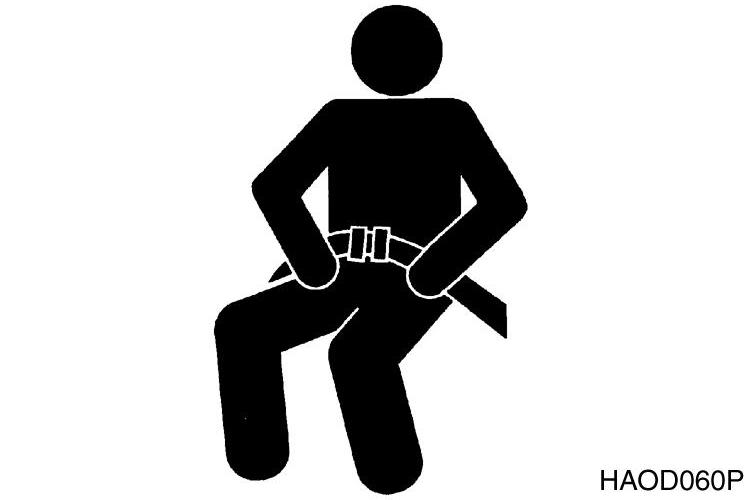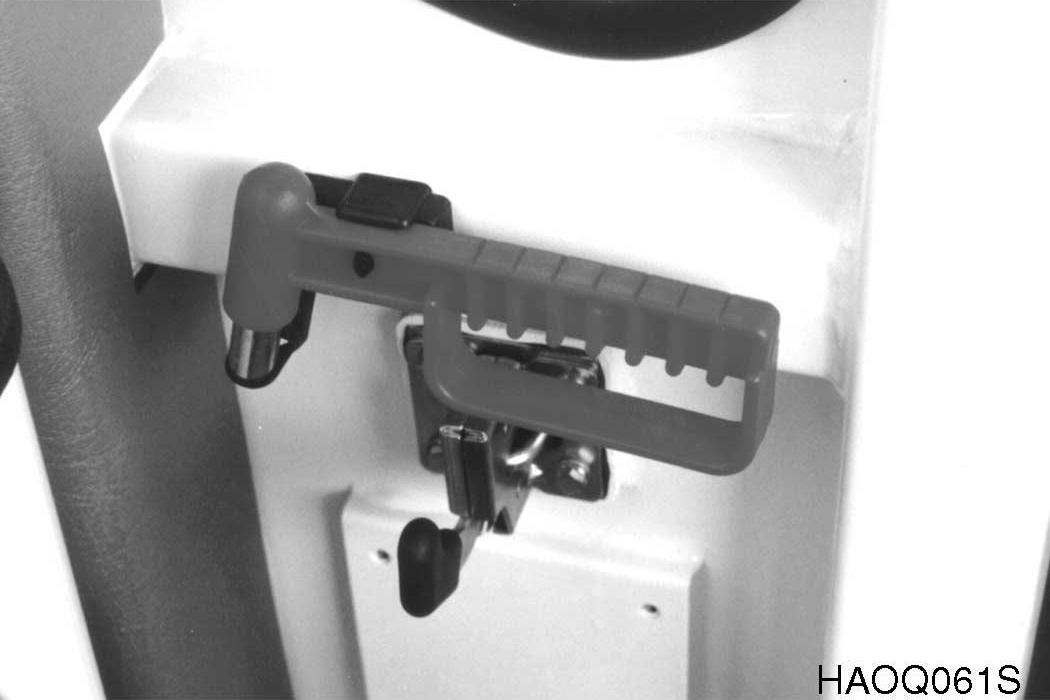
5 minute read
Equipment
SHUTDOWN CONTROL FUNCTIONS
After bucket has been lowered to overnight storage position, move all switches and controls to “OFF” position. Move parking brake switch to "LOCK" position. This will apply parking brake. Move pilot cutoff switch to "LOCK" position. This will disable bucket control lever. Move key in ignition switch to “OFF” position, and remove key from switch. Engage all lock-down security equipment that may have been installed on machine.
IMPORTANT
When hydraulic system maintenance or service work must be performed, be aware that accumulators in system store fluid under pressure after system has been shut down. To release hydraulic pressure in accumulators, operate control with engine "OFF" until accumulator pressure is completely dissipated.
EQUIPMENT
ROUGH OPERATION MAY REQUIRE USE OF
CERTIFIED SAFETY EQUIPMENT
Work in mines, tunnels, deep pits or on loose or wet surfaces could produce danger of falling rock, roll over or hazardous flying objects. Additional protection for operator’s cab could be required in form of a FOPS/Falling Object Protective Structure and/or ROPS/Roll Over Protective Structure reinforcement system.
Any reinforcement system that is installed on machine must pass safety and certification standards and carry appropriate labeling and rating information. For example, most often added type of reinforcement system, FOPS, must meet or exceed Society of Automotive Engineers standard SAE J1356, “Performance Criteria for Falling Object Guards for Wheel loaders.” Never attempt to alter or modify any type of protective structure reinforcement system, by drilling holes, welding or remounting or relocating fasteners. Any serious impact or damage to system requires a complete integrity reevaluation. Reinstallation, recertification and/ or replacement of system may be necessary.
Figure 11
Figure 12
HAOA110L
HAOA100L
INSTALL ADDITIONAL SAFETY EQUIPMENT IF CONDITIONS REQUIRE
When working with a breaker or in some shear work applications, a front guard over windshield may be required. Windshield guard may or may not be OPS/certified, depending upon the specific application and working situation. Laminate glass protection for the front, side or rear windows may also be recommended depending upon particular site conditions. Contact your Daewoo distributor for available safety guards and/or recommendations if there is any danger of getting hit by objects that could strike the operator’s cab. Make sure that all other work site crew members are kept well away from wheel loader and safe from potential hazards.
MOVEMENT ALARMS
If wheel loader is equipped with an audible travel movement alarm, test alarm on a daily basis. Audible alarm should sound as soon as travel system is engaged.
SEAT BELTS SHOULD BE USED AT ALL
TIMES
Whenever engine is running, operator should be seated at the control station with seat belt properly engaged.
WINDOW GLASS BREAKING TOOL
This loader is equipped with a glass breaking tool. It is located in the lower left side of the cab just rear of the door. This tool can be used in case of an emergency situation which requires the breaking of glass to exit from the operator’s cabin. Grip the handle firmly and use the sharp point to break the glass.
Figure 13

Figure 14
It is recommended that an appropriately sized (2.27 kg [5 lb] or larger) multi-purpose “A/B/C” fire extinguisher be mounted in cab. Check and service fire extinguisher at regular intervals and make sure that all work site crew members are adequately trained in its use.
MAINTAIN STANDARD SAFETY EQUIPMENT IN GOOD CONDITION
Machinery guards and body panel covers must be in place at all times. Keep well clear of rotating parts. Pinch point hazards such as cooling fan and alternator drive belts could catch hair, jewelry or oversize or very loose clothing. Safety labels must be replaced if they are damaged or become unreadable. Information on labels gives work crew members an important safety reminder. Part numbers for each decal and required mounting locations are shown on pages 1-2 through 1-4 of this section.
SAFETY-CRITICAL PARTS MUST BE REPLACED PERIODICALLY
Replace following fire-related components as soon as they begin to show any sign of wear, or at regular periodic intervals, whether or not deterioration is visible: • Fuel system flexible hoses, the tank overflow drain hose and the fuel filler cap. • Hydraulic system hoses, especially the pump outlet lines and front and rear pump branch hoses.
• Keep mounting brackets and hose and cable routing straps tight. Hose routing should have gradual bends.
Figure 15
HAOA080L
HYDRAULIC CYLINDER SEALS REQUIRE PERIODIC REPLACEMENT
Check cylinder drift rate at regular intervals. Overhaul seal kits are available through Daewoo.
HIGH PRESSURE HYDRAULIC LINES CAN STORE A GREAT DEAL OF ENERGY
Exposed hydraulic hoses on arm or boom could react with explosive force if struck by a falling rock, overhead obstacle or other job site hazard. Extra safety guards may be required. NEVER allow hoses to be hit, bent or interfered with during operation.
OPERATOR’S CAB SHOULD BE KEPT CLEAN
Clean grease and dirt from pedals and controls. This contributes to safe operation. Cleaning also provides an opportunity to inspect equipment. Minor damage can be repaired or corrected before major problems result. Keep cab floor and consoles free of tools and personal items.
WEAR EYE PROTECTION AND SAFETY
CLOTHING – USE PROPER TOOLS
Contain long hair, and avoid wearing loose clothes or jewelry that could get caught in controls. Full eye protection, a hard hat, safety shoes and gloves may be required at job site. While working on machine, never use inadequate tools. They could break or slip, causing injury, or they may not adequately perform intended functions.
Figure 16
HAOA020L
BREATHING MASKS, EAR PROTECTION
MAY BE REQUIRED
Do not forget that some risks to your health may not be immediately apparent. Exhaust gases and noise pollution may not be visible, but these hazards can cause disabling or permanent injuries.
NOTE: Sound level in closed operator’s cab is 75 dB(A). Additional information on machine sound and vibration levels can be found in Shop Manual.
ASBESTOS FIBER HAZARD
Materials containing asbestos fiber can be present on job site. Breathing air that contains asbestos fiber can ultimately cause serious or fatal lung damage. To prevent lung damage from asbestos fiber, observe following precautions: 1. Use a respirator that is approved for use in an asbestos-laden atmosphere. 2. Use water for cleaning and for keeping dust down. 3. NEVER use compressed air for cleaning.
BATTERY ELECTROLYTE AND EXPLOSIVE
GASES CAN BE LETHAL
Flush eyes with water for 10-15 minutes if acid is splashed in face. Anyone who swallows acid must have immediate medical aid. Call Poison Control listing in the front cover of the telephone directory. Explosive battery gas can be set off by sparks from incidental contact or static discharge. Turn "OFF" all switches and engine when working on batteries. Keep battery terminals tight. Contact between a loose terminal and post can create an explosive spark.
Figure 17
HAOA440L
DISCONNECT BATTERIES BEFORE ELECTRICAL SERVICE OR ELECTRICAL WELDING
Remove cable to negative terminal first when disconnecting cable. Connect positive terminal cables first when installing a battery.



